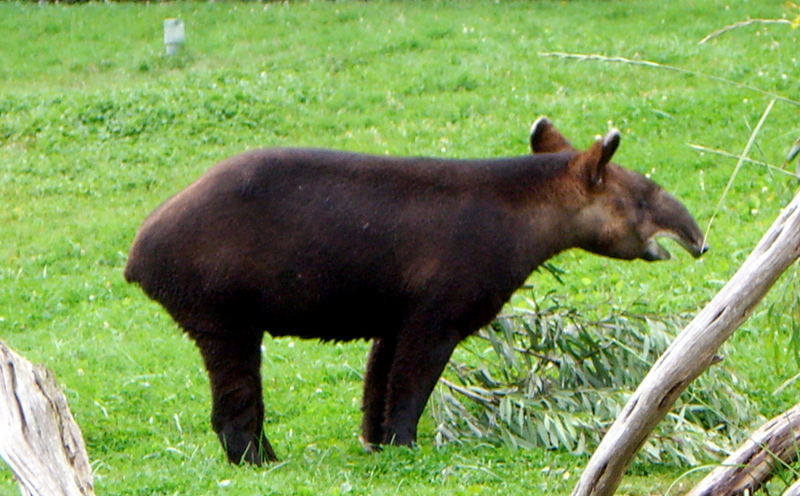Mountain Tapir (Tapirus pinchaque) - Wiki Mountain Tapir
From Wikipedia, the free encyclopedia
[Photo] Mountain Tapir (Tapirus pinchaque) at the San Francisco Zoo on September 1, 2007. Photo by Elissa Berver.
The Mountain Tapir (Tapirus pinchaque) is the smallest of the four species of tapir and is the only one to live outside of tropical rainforests in the wild.
The Mountain Tapir is referred to as Sacha Huagra by Quechua speakers, danta cordillerana (cordilleran tapir) and danta lanuda (woolly tapir) by Spanish-speakers in Colombia, danta negra (black tapir) by Spanish-speaking Ecuadorians, and tapir de altura (tapir of the heights) or gran bestia (large beast) by Spanish-speaking Peruvians.
The species name comes from the term "La Pinchaque", an imaginary beast said to inhabit the same regions as the Mountain Tapir.
General Appearance and Characteristics
The Mountain Tapir is most easily recognized by its wooly coat (it is sometimes referred to as the wooly tapir) and its white lower lip.
Mountain Tapirs may have greyish-black or brown coats, often depending on where they live, and often the hair around their cheeks is lighter.
Adults are usually around 1.8 meters (6 feet) in length and 0.75 to 1 meter (2.5 to 3 feet) in height. They typically weigh between 150 and 225 kilograms (325 to 500 pounds). The females are more often larger than the males, but usually the sexes are indistinguishable by size. Like the other types of tapir, they have small stubby tails and long, flexible proboscises. They have four toes on each front foot and three toes on each back foot.
Life Cycle
The gestation period of the Mountain Tapir is approximately 400 days, after which a single offspring is born. It is very rare for more than one young to be born at once. The newborn young weighs about 7 kilograms (15 pounds) and, like all species of tapir, has a reddish-brown coat with white spots and stripes. However, like the adults of their species, baby Mountain Tapirs have wooly fur to help keep them warm. The immature coloration fades after about a year, around the time when the young animal is weaned. Mountain Tapirs reach sexual maturity at age three and can live up to 30 years.
Behavior
When around other members of their species, Mountain Tapirs communicate through high-pitched whistles, and the males occasionally fight over estrous females by trying to bite each other’s rear legs. But for the most part, Mountain Tapirs are shy and lead solitary lives, spending their waking hours foraging for food on their own along well-worn tapir paths. Despite their bulk, they travel easily through dense foliage, up the steep slopes of their hilly habitat, and in water, where they often wallow and swim. The Mountain Tapir is primarily active from sundown to sunup when it forages for tender plants to eat, and it sleeps for much of the day. When trying to access high plants, it will sometimes rear up on its hind legs to reach and then grab with its prehensile snout. It also seeks out natural salt licks to satisfy its need for essential minerals. Though its eyesight is lacking, it gets by with its keen senses of smell and taste, as well as the sensitive bristles on its proboscis.
Male Mountain Tapirs will frequently mark their territory with dung piles, urine, and rubbings on trees, and females will sometimes engage in these behaviors as well. The territories of individuals usually overlap, with each animal claiming over 8 square kilometers (3 square miles).
Habitat
The Mountain Tapir is found in the cloud forests of the Andes in Colombia and Ecuador. There are reports that a small group may still be found in northwestern Peru, but these populations may be extinct. The species needs continuous stretches of cloud forest, rather than isolated patches, to successfully breed and maintain a healthy population, and this obstacle is a major concern for conservationists trying to protect the endangered animal. The Mountain Tapir lives at elevations of 1,950 to 4,400 meters (approximately 6,400 to 14,400 feet), and since at this altitude temperatures routinely fall below freezing, the animal’s wooly coat is essential.
During the wet season, Mountain Tapirs tend to inhabit the forests of the Andes, while during the drier months, they move to the p??ramo where there are fewer biting insects to pester them.
Vulnerability
The Mountain Tapir is the most threatened of the four tapir species, classified as "Endangered" by the IUCN in 1996. Some scientists predict that the species could be extinct as early as 2014. There may be only 2,500 individuals left in the wild today, making it all the more difficult for scientists to study them. There are also very few individuals found in zoos. Only a handful of breeding pairs of this species exists in captivity in the world ??? at the Los Angeles Zoo, the Cheyenne Mountain Zoo in Colorado Springs, and, as of 2006, the San Francisco Zoo. None are in captivity in the home range countries. The total of 9 individuals in captivity are descendants of just 2 founder animals. This represents a distinct lack of genetic diversity and may not bode well for their continued existence in captivity. The three zoos that house this species are working to ensure that the remaining wild populations of mountain tapirs are protected. In the wild, this tapir is hunted by the Jaguar and the Cougar, but deforestation for agricultural purposes and poaching are the main threats to the species.
http://en.wikipedia.org/wiki/Mountain_Tapir
| The text in this page is based on the copyrighted Wikipedia article shown in above URL. It is used under the GNU Free Documentation License. You may redistribute it, verbatim or modified, providing that you comply with the terms of the GFDL. |
